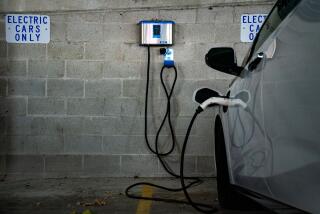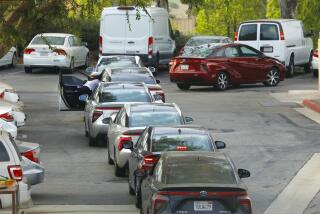Flywheel May Give Electric Car a Charge : Autos: Sacramento utility unveils model of high-tech battery it believes could make such vehicles practical.
In what its backers called a breakthrough in efforts to make electric cars practical and affordable, a Sacramento utility Thursday unveiled the first working model of a battery that stores energy in a high-tech flywheel.
The device, which stores energy mechanically, uses the same principle that keeps a yo-yo or potterâs wheel spinning. It was designed by American Flywheel Systems Inc., a small Bellevue, Wash., company, and built by Honeywell Inc. of Minneapolis, which since the 1970s has been building flywheels for aerospace and defense projects.
Some familiar with the technology say substantial technological hurdles remain. But a spokesman for its chief sponsor, the Sacramento Municipal Utility District, was optimistic as the designers announced the development in Seattle.
âWe believe the AFS-Honeywell teamâs flywheel battery will transform the market for electric cars, making them truly long-range vehicles,â said Winston Ashizawa, SMUDâs deputy assistant general manager.
Ashizawa estimated that a full-size prototype engine could give electric cars a range of 300 to 600 miles between charges--as much or more than conventional gasoline autos. The best existing chemical batteries last 120 miles between charges.
âA long-range electric vehicle is of far more general service,â Ashizawa said, âso instead of it being a second car, it could be the first car for a family, dramatically improving its marketability.â
Proponents also believe that in mass production, a flywheel battery car could be priced competitively with gas-powered autos and be operated more cheaply.
Flywheels spin like tops, speeding up as they store energy and slowing as the energy is used--to propel a car, for instance. They were widely researched in the 1970s and 1980s, when alternative-energy schemes were well-funded. But with the fall in oil prices in recent years, interest tapered off. They also had a big technological drawback: They couldnât store enough energy.
But the new generation of flywheels--built from extremely tough materials, including graphite fibers and Kevlar, the synthetic material used in bulletproof vests--have much higher spinning speeds, allowing greater energy storage.
Research in flywheel technology has increased as the auto industry faces a 1998 deadline in California and other states to put the first electric cars on the road. Calstart, the consortium attempting to foster an advanced transportation industry in California, is seeking funds for a project with U.S. Flywheel Systems Inc. of Laguna Hills. Hughes Aircraft Co. and Lawrence Livermore National Laboratory are also working on flywheel systems.
Others see substantial problems before flywheels prove practical.
Philip C. Symons, manager of public transportation projects at the Electric Power Research Institute, the research arm of the utility industry, recently evaluated the state of the technology. He worries that flywheel cars could prove overly expensive. And while flywheels themselves have dramatically improved, related components have not, he said.
âWhat we donât know as yet is how well we will be able to reduce the weight of all these other subsystems so that we can obtain usable energy,â Symons said.
SMUD and other electric utilities would reap vastly increased revenues in any big switch from gasoline to electric cars. But the utilities have sought to encourage technologies that would lend themselves to overnight recharging, when the utilities have great excess capacity.
For that reason, SMUD favors a long-range vehicle that could accommodate a familyâs needs all day. So far, the utility has contributed federal and state grants totaling more than $2 million to the AFS flywheel battery development.
SMUD expects a battery prototype that can be tested by auto makers in 1994 and a full-size prototype by 1995.






